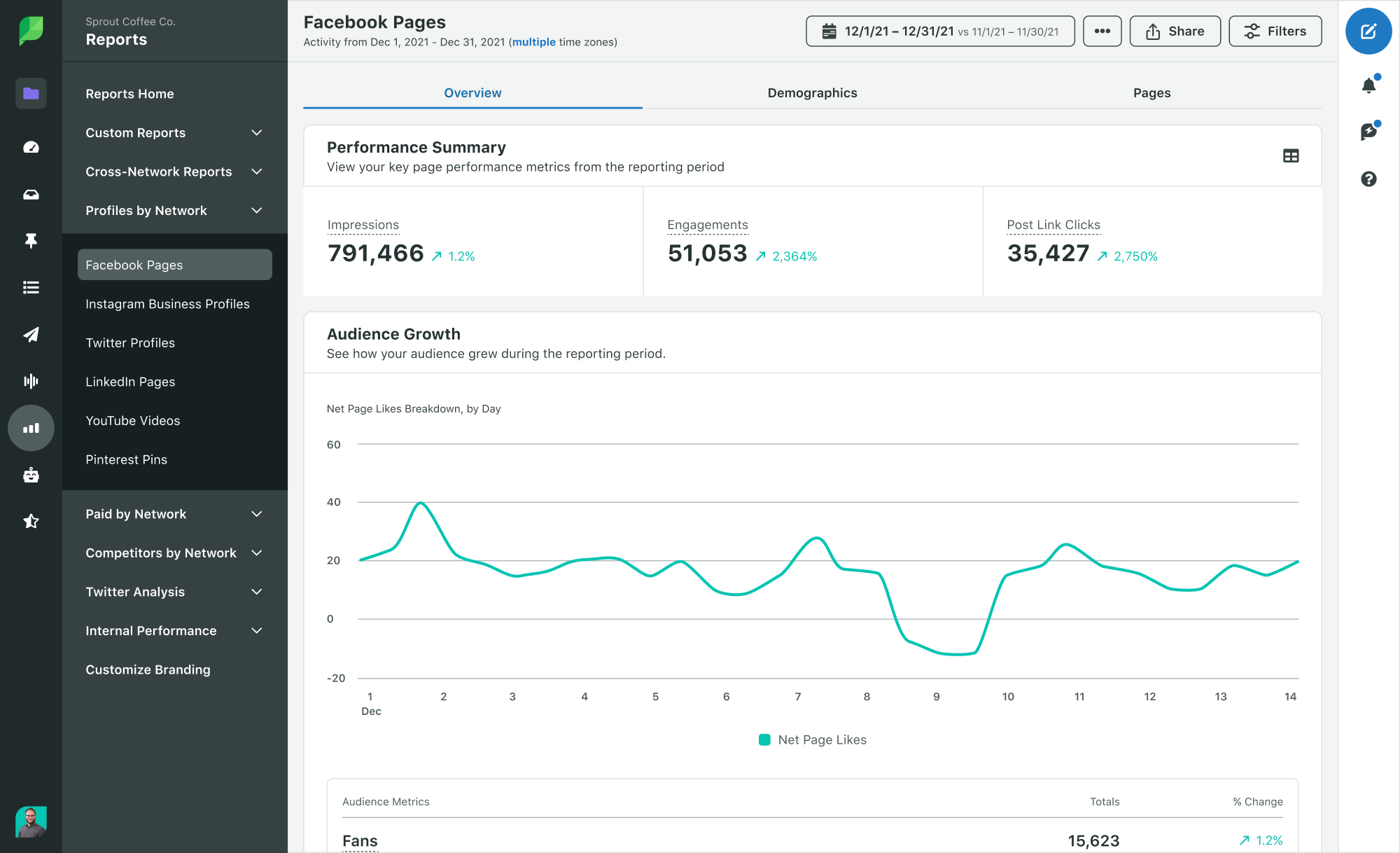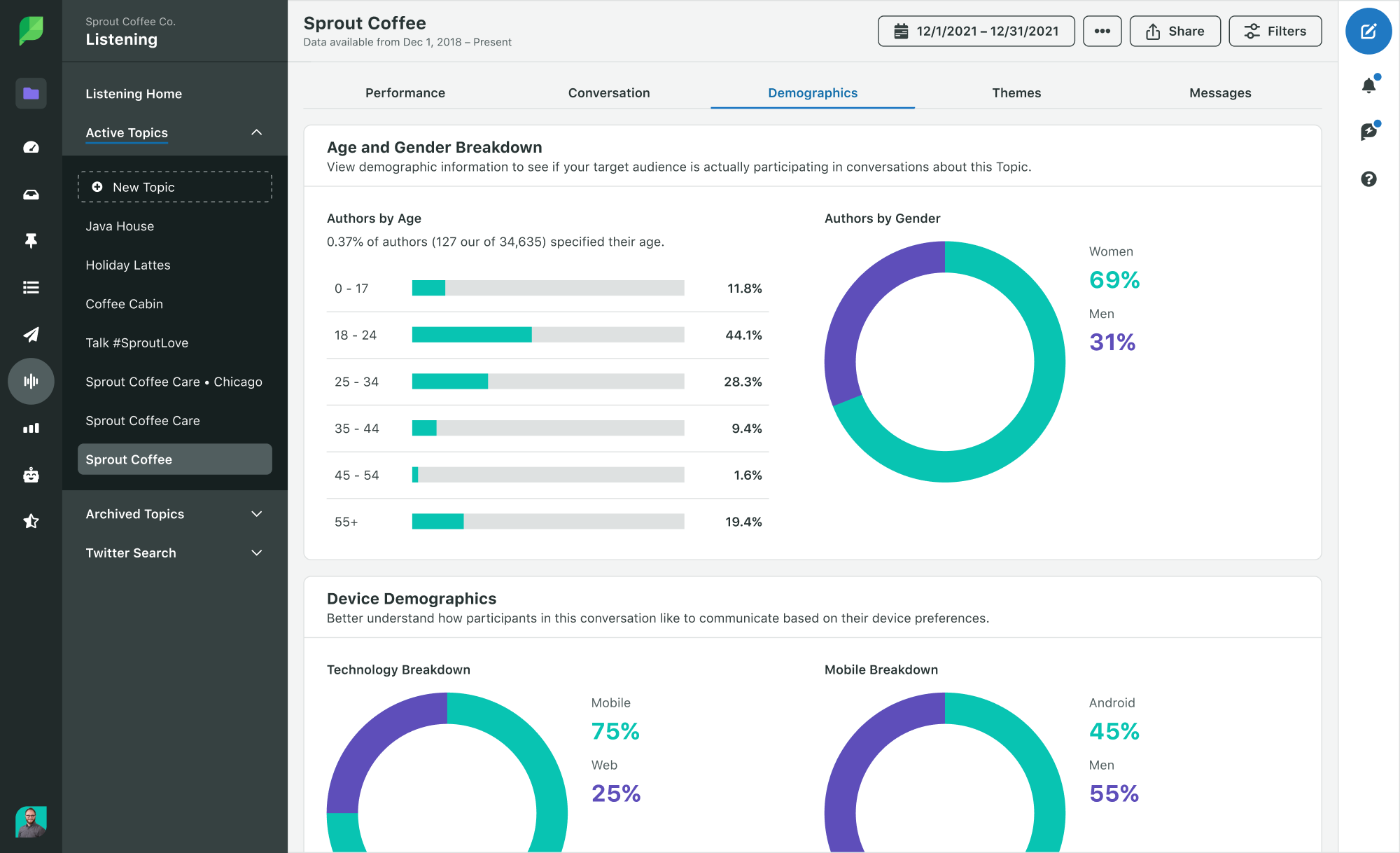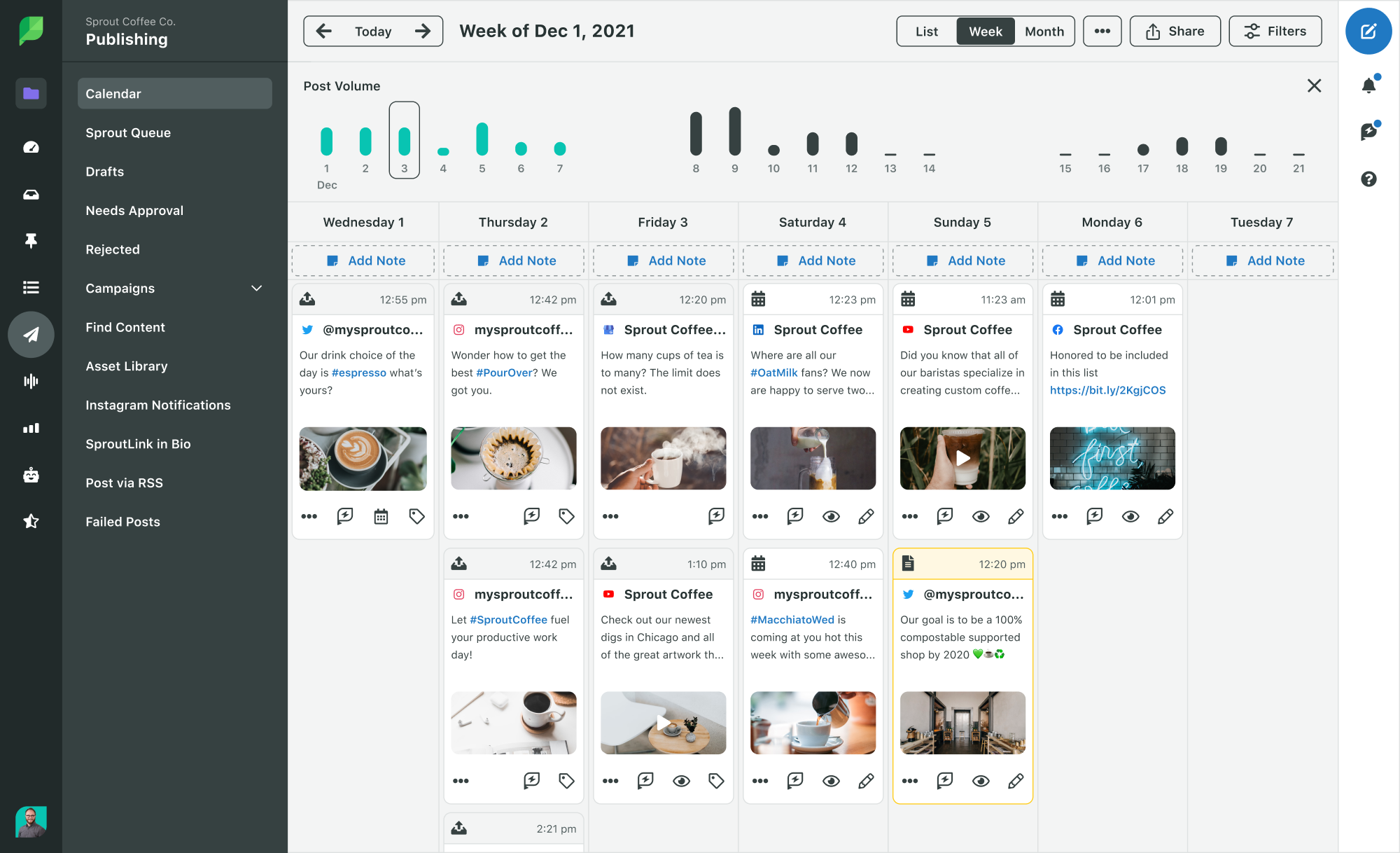
Facebook Marketing
Facebook Marketing Guide: 9 Strategies to Succeed
Reading time 10 minutes
Published on December 12, 2022

Table of Contents
Throughout the years, we've seen various social media platforms have their rises and falls—but through it all, Facebook has remained a powerhouse. With nearly 3 billion monthly active users, Facebook is by far and wide the most-used social media network.
This means it's a great place for your business to have a presence. However, you need to understand how to create a Facebook marketing strategy that will succeed.
In this article, we're going to touch on various Facebook marketing tactics you should employ within your overarching social media strategy, and how to get started.
Watch the video below to hear why you shouldn’t sleep on incorporating Facebook into your strategy:
What is Facebook marketing?
Facebook marketing is the act of promoting a business and its products/services on Facebook via a business page. By fully optimizing your business page, brands can create a second website of sorts, even making sales directly on Facebook.
While newer platforms like Instagram and TikTok improve overall viral potential, Facebook is still a good home base for many businesses—plus its ad platform is one of the most sophisticated of its kind. With the ability to create various Facebook post types (i.e., photos, carousels, videos, links), create a shop and advertise products and services directly to your target audience, you don't want to sleep on Facebook.
Creating a Facebook business page is easy:
- Head to Facebook.com and log into your personal account
- Click the menu icon in the top navigation bar
- Click Page under the Create menu
- Input your business name and information
- Brand the Page with your logo, a cover photo and other pertinent information
Then you're ready to get started creating your Facebook marketing strategy.
How to create a Facebook marketing strategy
Once you have your Facebook business page set up, you need to start marketing it to increase the number of people who like the page as well as the number of people who see and interact with your page content. Consistently creating content that engages your audience is key—as well as these top 9 tactics to employ within your strategy.
1. Set goals for your Facebook marketing
The first step to any marketing strategy is setting the right goals. These goals and objectives will be an essential reference to measure against to make sure your Facebook strategy is successful.
In the 2022 Sprout Social Index, we found that marketers and consumers still prefer Facebook as their primary social platform for connecting with their target audience.
- 71% of consumers anticipated using Facebook the most in the next 12 months
- 65% of marketers anticipated using the platform
Other common Facebook marketing goals include:
- Increasing the overall quality of your sales: Improving the quality of sales starts with better targeting. You reach your target audience more efficiently through a well-planned Facebook marketing strategy. Test various targeting options to see which generates the best results.
- Adding more value to the organization: Facebook can help you nurture customers, improve awareness and provide more resources to your audience. Make Facebook your go-to source of information, essentially creating a second website by adding all pertinent details about your business, building your social media store and more.
- Better pulse on the industry: Are your competitors always one step ahead? With the help of social media listening tools, you can track, listen to and report on all social conversations revolving around you, your competitors or the industry.
- More efficient recruiting: Social recruiting is only growing in popularity as social media sites like Facebook can be a great source for increasing recruiting efforts and reaching top talent faster. Facebook also allows you to create job listings that make it even easier to find top talent.
- Smarter growth: Reducing churn, limiting spend and increasing acquisition are all parts of a successful business, and Facebook can help you in each of these areas. Whether it’s through ad spend, increased targeting or more social selling, addressing your Facebook marketing strategy can help you get closer to these goals.
- Tracking progress: Of course, making sure you’re on pace to accomplish these goals is essential, and with a tool like Sprout, you can easily keep tabs on all your Facebook reporting such as displayed in the picture below.

2. Know your Facebook audience
Understanding who is on Facebook and what your target audience breakdown looks like will be important in determining which Facebook marketing strategies you should employ and how. Sprout Social’s deep dive into social media demographics is a great starting point for getting a general sense of who is using the platform and how.
Once you’ve studied up on that, you can spend some time getting familiar with your own Facebook demographics using either Facebook Page Insights or a tool like Sprout.

Knowing your Facebook audience will help you understand the right types of content to publish that will generate the most engagement and resonate best with your followers. The goal is to increase engagement and eventually sales, and publishing the right mix of content (which we'll touch on next) can help you do that.
3. Publish a mix of content to your Facebook feed
We've already mentioned the variety of post types you can create on Facebook. To make sure you create an engaging feed with exciting content, you want to publish a good mix of content. This way your feed isn't boring and predictable—it's fun and interesting to follow.
This showcases just a few different pieces of media you can add to a Facebook post:

- Allow your followers to message you directly through WhatsApp or Facebook Messenger
- Tag products in your photos for followers to immediately make a purchase
- Support local charity organizations by adding fundraisers
- Create humorous content by attaching GIFs to engage your audience
There are many different ways to create a solid mix of content for your Facebook followers—make sure you're fleshing out a full social media calendar so you can balance out the types of content you create.
Be sure to include content types that help with your bottom line. This includes content like video, images, stories and livestreams.

4. Post when your followers are most active
Even though 87% of consumers are on Facebook, it's still one of the most difficult social networks to use. Organic content and algorithms make it a challenging for businesses trying to find optimal posting times. However, our guide on the best times to post on Facebook outlines the do’s and don’ts of posting on Facebook:

It's said that only a fraction of Facebook followers will see your content, but paying attention to when your specific audience is online can help. Keep an eye on your Sprout analytics and your Facebook insights to gain a clear understanding of when your audience is most likely to interact with your content.
5. Schedule your Facebook content
Content creation and curation are important components of any social media strategy. But if you're posting everything in real-time, you'll be a slave to your Facebook marketing strategy and won't have much time for anything else. This is why scheduling your content out in batches is key.
For scheduling Facebook content, you have both free and paid options available to you. Facebook’s Page controls allow you to schedule your posts right from your own page. Sprout’s ViralPost feature will pick the best times for you based on your highest expected audience engagement.
Scheduling and planning your calendar makes it easier for you to see where gaps are in your posts. Using a tool like this will save you time in the long run.

6. Engage proactively with your audience
Like most social media channels, they’re built as networks to converse, discuss and share content. As a brand, you can’t forget that basic idea of what makes a social media network—that means conversation and engagement should never be put on the back burner.
Instead, try to build a community for your audience. Facebook is a great place to hold industry chats or discussions, whether it’s with a different audience or your own customers. While Twitter often gets all the limelight of being a social customer care mecca, don’t forget Facebook can be used to build customer care relationships.
You can help drive Facebook engagement by asking people to simply engage in the first place. However, you can’t sit back and wait for your followers to interact. You can’t reach everyone, but there are ways to increase engagement.
For example, Bath & Body Works will respond to comments left on their Facebook posts, even going so far as to offer product recommendations. This is a great way to increase engagement—as we can see, this post has 207 comments overall.

Work to create content that solicits engagement from your audience—but also don't be afraid to ask for engagement as well. Have your audience react to your posts to vote on something. Ask questions. Share polls. The possibilities are endless, and you can easily start building up engagement and community through Facebook.
7. Use Messenger to build relationships with customers
Facebook Messenger can help you build relationships, make sales and even improve customer service. Adding a button for someone to message you directly is one of the many options of media you can add to a Facebook post. You can also make the CTA button at the top of your business page a CTA to message your brand.
Then, you can easily have someone on your social team man the Messenger inbox, or you can set up social media automation features to manage it. If you choose to set up a bot, you can easily add premade questions and answers, allow users to shop via Messenger and more.
Here's a great example of what a bot might look like from monday.com:

There are four questions that users can ask and get an immediate, automated response. However, users can also message with other questions or concerns and get a customer success manager's response in real-time.
Messenger gives you a unique opportunity to have a direct conversation with individual consumers. Make sure to add this to your Facebook marketing strategy in whatever capacity makes sense for your brand.
8. Determine your Facebook ads strategy
Whether you’re just starting out on Facebook or you’ve been on it for a while, it’s difficult to escape the need to pay for brand exposure—especially if you want to reach more than 6% of your followers. Our comprehensive guide to creating your Facebook advertising strategy is a great place to start learning more about Facebook ads.
Determine your monthly ad budget and try to keep ads consistently running to increase reach, generate more sales and build brand awareness.
Build out proper ad targeting
Your Facebook ad campaigns should always be focused on two things:
- Cost-effective
- Relevant
For starters, you want to stay within your allocated monthly spend to avoid overexposure, a low relevance score and useless clicks. This means your Facebook ad has to be relevant. Targeting a broad audience isn’t a bad thing, especially at first, so you can see what works best to build awareness. However, relevance is crucial for great Facebook ads.
Build out custom audiences based on user behavior and interests as well as lookalike audiences based on your website visitors to find potential customers who would be most interested in your Facebook content and your products or services. If it’s a retargeting measure, make sure the content provides something recognizable but also something new.
Design your creative assets
Earlier in this post, we did a deep dive into the types of content on Facebook. Now it’s time to choose which pieces of content you think are worth advertising in front of a much larger audience. You can boost pre-existing content to reach a larger audience or simply recreate some of your most successful post types within an ad format.
Some of the best aspects of your ad content should include:
- Identity: Does it relate to your brand and effectively showcase your product/service? Are your logo and business colors correctly displayed?
- Reward: What do viewers get out of it? Is it a deal, promotion, offer code, whitepaper or industry guide?
- Tone: Does your content maintain the same tone across your entire Facebook page or business in general?
- Action: Your content must drive an action, which goes back to your Facebook goals. A clear and precise call to action is best.
Use product photos, branded graphics or videos to help capture your audience's attention and reel them into your ad. Make sure your ad copy helps to further your ad and entice the viewer to take action.
Keep Facebook ad content fresh
Most Facebook ads are seen as users scroll through their feeds. This means some of them are seen quite often, which can quickly lead to ad fatigue. Have you ever seen a TV commercial replayed endlessly through your favorite show? By the end, you're likely going to be extremely annoyed and have no interest in the brand. This is the same thing.
Don’t let your content get stale with viewers, so make sure to update and repurpose your ad content every week or two. The whole purpose is to drive users to a specific site or purchasing page. So don’t let old content ruin your Facebook retargeting or remarketing efforts.
Create a spreadsheet and document your core metrics. Each metric will provide you with unique insights into what you specifically want to achieve with your ad:
- Click-through rate: If traffic is essential, track CTR and see where you can improve.
- Impressions: Having trouble with visibility? Revisit your image or content and see what can drive more impressions.
- Cost to acquire: If your purpose is to limit spend and budget more effectively, track cost to acquire and set weekly or monthly goals.
9. Track & analyze your results
The last step of your strategy is to keep an eye on the metrics you identified earlier in goal setting and analyze the results. This also includes determining your ROI.
You can use Sprout Social to keep track of your Facebook analytics to see if you need to change the types of content, ads and engagement strategies you're employing or if what you're doing is working.

Watch to see if your Facebook performance is increasing or decreasing month-over-month so you can make any necessary changes to create the quintessential Facebook marketing strategy.
Get started with Facebook marketing today
Start promoting your business with a comprehensive Facebook marketing strategy. To help you get started, take advantage of our Facebook marketing template. Learn even more about increasing engagement, reach and, ultimately, sales through your social media platforms.
Facebook Marketing FAQs
Are there Facebook marketing courses?
Yes! Users can find free courses on Facebook marketing on Meta Blueprint for those who want to strengthen their marketing skills across Facebook, Messenger, Instagram and WhatsApp.
How do I create a Facebook business page?
It’s easy to create a Facebook business page! Head to Facebook.com and click the menu icon (nine dots) in the top navigation bar. Click Page under the Create menu to get started. From here, Facebook will walk you through all of the information you need to fill out in order to completely optimize your business page.
Additional resources for Facebook Marketing
Creator Studio for Facebook and Instagram: A guide for marketers
Facebook Marketing Guide: 9 Strategies to Succeed
12 Facebook marketing tools to help your business scale
7 Fundamental Facebook best practices to grow your presence faster
The picture-perfect Facebook cover photo size
How to build your community with Facebook Groups
A step-by-step guide on how to use Facebook Business Manager
5 brilliant Facebook campaigns (& why they worked)
15 Facebook post ideas to increase engagement
How to use Facebook tools to boost your success
13 Ways to use Facebook events for your brand
Expert tips on using Facebook for your small business
The new Facebook features every marketer should know about
Instagram vs Facebook: which is best for your brand’s strategy?
11 Facebook marketing tips that will leave competitors in the dust
Facebook automation: What your brand doesn’t know
Your Handy Guide to Facebook Marketing Terms





















